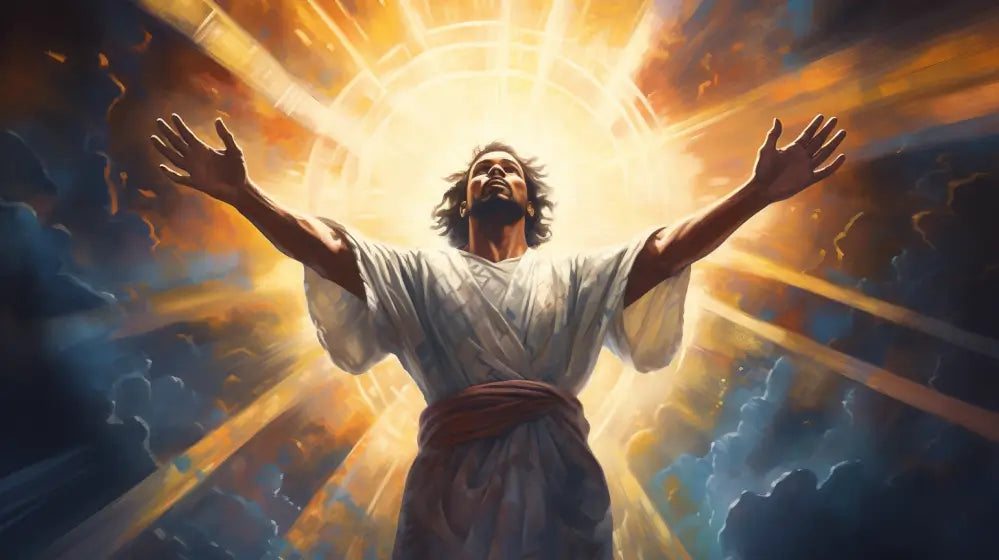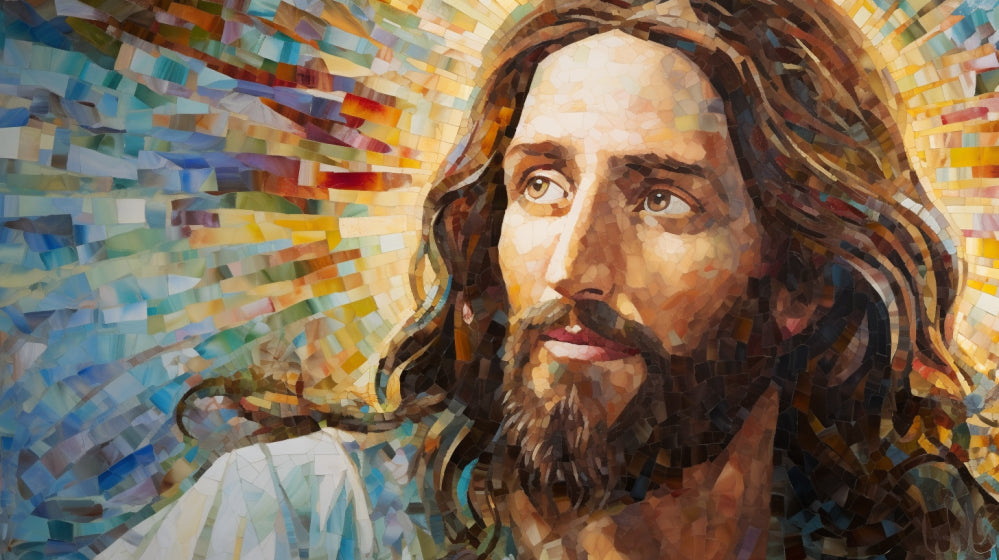
Is Jesus White or Black
Share
We've all heard it before: a blue-eyed, blond-haired Jesus is the only way to go. But is this actually accurate? In this article, we'll explore the origins of the image of Jesus, the various depictions of him over time, and the implications of his appearance. We'll dive into evidence from the Bible, early Christian art, and cultural influences from around the world to uncover the truth behind Jesus' racial identity. So, buckle up, because it's time to challenge the white Jesus narrative and explore what representation really means.
In this article, we'll explore the origins of the image of Jesus, the various depictions of him over time, and the implications of his appearance. We'll dive into evidence from the Bible, early Christian art, and cultural influences from around the world to uncover the truth behind Jesus' racial identity. So, buckle up, because it's time to challenge the white Jesus narrative and explore what representation really means.


 Through this article, we'll provide an overview of the purpose and structure of the discussion surrounding the question of whether Jesus is white or black. We'll explore:
Through this article, we'll provide an overview of the purpose and structure of the discussion surrounding the question of whether Jesus is white or black. We'll explore:































 In this article, we'll explore the origins of the image of Jesus, the various depictions of him over time, and the implications of his appearance. We'll dive into evidence from the Bible, early Christian art, and cultural influences from around the world to uncover the truth behind Jesus' racial identity. So, buckle up, because it's time to challenge the white Jesus narrative and explore what representation really means.
In this article, we'll explore the origins of the image of Jesus, the various depictions of him over time, and the implications of his appearance. We'll dive into evidence from the Bible, early Christian art, and cultural influences from around the world to uncover the truth behind Jesus' racial identity. So, buckle up, because it's time to challenge the white Jesus narrative and explore what representation really means.
Key Takeaways
- The portrayal of Jesus as white and European has a long history, beginning with Renaissance artists who depicted him in their own likeness.
- The spread of white Jesus imagery was influenced by European trade, colonization, and missionary efforts, which served to justify European dominance and colonization.
- There is no scholarly agreement on Jesus' appearance, and early depictions of him varied greatly.
- Biblical references and literary traditions offer contradictory descriptions of Jesus' appearance, with some emphasizing his physical unattractiveness and others arguing for his ideal beauty.

Is Jesus White or Black
Jesus' racial appearance has been a source of debate and discussion for centuries, and is an important topic to explore. In this article, we'll discuss the various historical influences, literary traditions, and spurious documents related to Jesus' racial appearance. Ultimately, we will address the question of whether Jesus is white or black.
Jesus portraits and the debate about his racial appearance
We have long been familiar with the traditional portrayals of Jesus as a white man, but recently, there's been a debate about his true racial identity. The conversation is complex and interdisciplinary, incorporating elements of art, history, and theology. Here are three aspects of the debate:- Historical Portrayal of Jesus as White and European
- Early Depictions of Jesus' Appearance
- Renaissance Artists and the Creation of White Jesus

Jesus' portrayal and its impact on different cultures and communities
Examining the history of Jesus' portrayal in art reveals its pervasive influence on cultures and communities around the world. From the Renaissance period to the present day, the image of a white European Jesus has been widely disseminated in various forms. This image of Jesus has been used to justify colonization and domination by European forces and has had a lasting impact on the perception of Jesus in different cultures. Scholars, theologians, and activists alike have called into question the historical accuracy of European depictions of Jesus. It's clear that race and religion have been intertwined in the creation of Jesus' images and their subsequent spread across the world. An honest and open examination of Jesus' portrayal is needed to ensure the fair treatment of people of all races and religions. Through this article, we'll provide an overview of the purpose and structure of the discussion surrounding the question of whether Jesus is white or black. We'll explore:
Through this article, we'll provide an overview of the purpose and structure of the discussion surrounding the question of whether Jesus is white or black. We'll explore:
- Historical Portrayal of Jesus as White and European
- Early Depictions of Jesus' Appearance
- Influence and Spread of White Jesus Imagery

The Historical Context of Jesus Portraits
Throughout history, images of Jesus have been influenced by European and Western ideals. To understand why, it's important to consider the early depictions of Jesus in art. These images were connected to the cultural and political forces of the time.
Early depictions of Jesus in art and their connection to European and Western influences
From the Renaissance period onwards, European artists began to portray Jesus in their own likeness. Today, this influence is still present in the dominant image of Jesus as a white European man. To understand the historical context of these portraits, it's important to examine the socio-cultural factors that shaped them.
European features became the dominant representation of Jesus
We trace the rise of European features in Jesus portraits back to Renaissance artists. From Antonello da Messina's self-portrait to Albrecht Dürer's, these works combined iconography and portraiture, creating a standardized image of Jesus. This image was then spread through European trade, colonization, and media.- Warner Sallman's 'Head of Christ' was widely reproduced.
- Andrea Mantegna's 'Adoration of the Magi' depicted a European-born Jesus.
- Anti-Semitic forces attempted to divorce Jesus from his Judaism.

Socio-cultural factors that affected the portrayal of Jesus' race
By examining the historical context of Jesus portraits, we can better understand the socio-cultural factors that shaped the portrayal of Jesus' race. Skin color, racial identity, and cultural influences all played a role in how Jesus was depicted in art. From early Christian artists relying on syncretism to Renaissance masters creating self-portraits of Christ, the image of a white, European Jesus gained dominance. This image continued to spread through colonization and was used to justify European power. Ultimately, the legacy of a white Jesus still impacts our perceptions today.
Challenging the White Jesus Narrative
For centuries, Jesus has been portrayed as a white man in artwork, literature, and other forms of media. However, there's growing evidence that challenges this narrative, as scholars, activists, and religious leaders alike are pushing for a more diverse representation of Jesus.
The arguments supporting a non-white Jesus
Recently, scholars, theologians, and cultural historians have argued for a non-white depiction of Jesus. This challenges the traditional white Jesus narrative, which has been heavily influenced by European colonialism and anti-Semitic forces. Historical evidence suggests Jesus had Middle Eastern physical characteristics.Historical evidence suggesting Jesus had Middle Eastern physical characteristics
We're challenging the white Jesus narrative by examining historical evidence suggesting Jesus had Middle Eastern physical characteristics. Brown or black hair, honey or olive-brown skin, and brown eyes are all traits associated with Judeans of the time, as well as having short hair and a beard. Documents detailing Jesus' appearance are considered forgeries, while anti-Semitic forces have tried to divorce Jesus from his Judaism. Through research, theologians and cultural historians advocate for a non-white depiction of Jesus, challenging current narratives.Perspectives of scholars, theologians, and cultural historians advocating for a non-white depiction
Advocating for a non-white depiction of Jesus, scholars, theologians, and cultural historians are challenging the white Jesus narrative. This argument is based on the lack of historical evidence, the influence of European colonization, and anti-Semitic forces. Syncretic images, such as the Good Shepherd, and Renaissance portraits have shaped the idea of a white Jesus. However, some artworks depict Christ with Ethiopian and Indian features. Respecting the divine and human nature of Jesus, these advocates call for a re-examination of the man and God.
The prevalence of white Jesus imagery within Christian communities
We examine the influence of European colonialism, media, and popular culture on the perpetuation of the white Jesus narrative. Through an analysis of historical and contemporary sources, we explore the ways in which the white Jesus image has become embedded in Christian communities across the world.
The influence of European colonialism on the spread of white Jesus portrayals
Our colonialism's influence on the proliferation of white Jesus depictions is undeniable. Christian communities in the West and beyond are largely shaped by the American narrative of a white Jesus, which was spread through colonialism. This includes: 1) The forceful imposition of European standards on indigenous artwork. 2) The marketing of a white European Christ through Christian publishing companies. 3) The forceful spread of white Jesus imagery through European trade and colonization. Such practices have had a lasting impact on how Jesus is viewed and portrayed, and should be addressed.
The role of media and popular culture in perpetuating this narrative
Building off of the influence of colonialism on the proliferation of white Jesus depictions, media and popular culture have been instrumental in maintaining the white Jesus narrative. Christians, the Bible, and the Church have all served to propagate this image of a white savior. Movies, TV shows, literature, and art have all been used to portray Jesus as a white man, sometimes without justification. This has caused many to question the validity of the narrative and its implications for faith and humanity.
Representation Matters: The Importance of Diverse Jesus Portraits
As people of faith, we recognize the importance of visual representation of figures like Jesus. We need to consider the powerful influence of images of Jesus on communities of color. That's why it's vital to explore the works of contemporary artists who've created diverse interpretations of Jesus' racial appearance.
The impact of visual representation on communities of color
We are all familiar with traditional portrayals of Jesus as a white man. But how does this visual representation affect communities of color? Representation matters, and the importance of diverse Jesus portraits is clear.
The empowerment and sense of inclusion that diverse Jesus portraits can bring
By appreciating diverse Jesus portraits, we can help bring a sense of empowerment and inclusion to communities of color. From a human perspective, representation matters: it helps us to connect to our faith and our family. From a nation perspective, it helps strengthen our unity and encourages respect for others. Representation contributes to a more inclusive worship experience - one that's open to all and celebrates diversity.
How representation contributes to a more inclusive and diverse worship experience
Frequently, representation of Jesus through artwork and other visuals can create a more inclusive and diverse worship experience for communities of color. This is especially true when they depict a true, middle ground that's good for all. Churches and other religious organizations are recognizing the importance of representation and seeking to make their spaces and services more welcoming for people of color. These efforts can help create a greater sense of belonging and connection, which is key to a fulfilling worship experience. To showcase contemporary artists and their interpretations of Jesus' racial appearance, we must look no further.
Contemporary artists and their interpretations of Jesus' racial appearance
We explore how contemporary artists are challenging traditional depictions of Jesus by presenting their interpretations of his racial appearance. Through their work, these artists are contributing to a larger conversation about the importance of diverse representation, making visible the intersection of faith and race.
Artworks that depict Jesus with various ethnic backgrounds
As we explore the importance of diverse Jesus portraits, let's take a look at some contemporary artworks that portray Jesus from various ethnic backgrounds:- The book, 'Representation Matters', showcases art from around the world that looks at Jesus through various cultural lenses.
- The biblical-inspired artwork of African-American artist, Michael Moses, is an example of Jesus depicted with black features.
- The Spanish artist, Jesús Matheu, reimagines the image of Christ in his art, incorporating traditional techniques and elements from his culture.

Artistic choices made by artists in their portrayal of Jesus
Exploring the artistic choices made by contemporary artists in their portrayal of Jesus, it's clear that there's a shift away from the traditional image of a white European Jesus. In recent centuries, depictions of Jesus as dark-haired, dark-skinned, and of Jewish descent have become increasingly popular. These portrayals are reflective of a growing awareness of the importance of representation and the need to honor Jesus' true identity. The reimagining of Jesus also serves as a reminder of the power of art to challenge long-held beliefs and to foster greater understanding and empathy.
Theological Perspectives on Jesus' Racial Identity
As we explore the question of Jesus' racial identity, it's important to consider theological perspectives and examine biblical teachings that may shed light on this issue. Different theologians and religious scholars have varying views on the significance of Jesus' race and its impact on Christian faith.
Biblical teachings that may shed light on the racial appearance of Jesus
We investigate the biblical teachings on Jesus' racial identity to understand the theological perspectives that may inform how Jesus is depicted today. In particular, we examine the cultural context of biblical stories to explore how it may shape the physical description of Jesus. We also explore the concept of Jesus as a universal figure transcending racial boundaries.
The cultural context of biblical stories and how it may influence Jesus' physical description
Our examination of theological perspectives on Jesus' racial identity reveals insights into how biblical teachings may have shaped Jesus' physical appearance. From the Old Testament's reference to eyes of mercy to the New Testament's description of Jesus in books and churches, there are clues to his identity. We can look to: 1) the color of his eyes; 2) the stories told in books; 3) and representations of Jesus in churches. Together, these elements may provide clues to Jesus' true identity and the cultural context in which he lived.
Jesus as a universal figure transcending racial boundaries
Drawing from biblical teachings, Jesus is often seen as a universal figure that transcends racial boundaries. We must read between the lines to understand God's intentions and the significance of Jesus' racial identity. Different theological viewpoints emphasize the importance of Jesus' message, rather than focusing on his physical appearance. This emphasizes a spiritual connection to Jesus, rather than a physical one, and is a reminder of Jesus' role as a messenger of God's love. This transition leads us to examine the present different theological viewpoints on the significance of Jesus' race.
Different theological viewpoints on the significance of Jesus' race
We explore the implications of Jesus' racial identity for theological traditions. We consider the importance of understanding Jesus' cultural context for a holistic interpretation. While many believe Jesus was a white man, there's still much debate surrounding his exact appearance and the significance of his race within a theological context.
The implications of a non-white Jesus for various theological traditions
As we explore the implications of a non-white Jesus for various theological traditions, it's important to consider the different viewpoints on the significance of Jesus' race. To enable this, one must consider: 1) the image of Jesus historically presented to the world; 2) how this view has been shaped by cultural, political, and theological factors; and 3) how this image can be challenged to enable greater understanding of Jesus and his teachings. This discussion can help us view Jesus in a more holistic and meaningful way, ultimately serving others.
The importance of understanding Jesus' cultural context for a holistic interpretation
Building on our exploration of the implications of a non-white Jesus for various theological traditions, let's now consider the importance of understanding Jesus' cultural context for a holistic interpretation of his racial identity. To find beauty in a non-European Jesus, we must learn to recognize Jesus in his own cultural context. This is especially important in America, where the legacy of white Jesus imagery remains strong. We must look to the source material to gain a fuller understanding of Jesus' racial identity.
Navigating the Tensions: Unity in Diversity
As individuals of diverse backgrounds grapple with the question of Jesus' racial identity, it's important to emphasize the commonalities that bring us together.
Encourage respectful dialogue and understanding between individuals with differing views on Jesus' racial appearance
How can we navigate the tensions between individuals who have differing views on Jesus' racial appearance while still promoting unity in diversity? We must begin by recognizing the historical roots of the white European depiction of Jesus, and strive to understand the impact it has had on different cultures. We can then:- Create safe spaces for respectful dialogue to explore different perspectives.
- Listen to and validate the experiences of those who have been marginalized by a white Jesus.
- Highlight the shared values and teachings that can bridge the gap.

The shared values and teachings that can bridge the gap
We can bridge the gap between the historical portrayal of Jesus as white and European and the reality of his likely Middle Eastern appearance by looking to his shared values and teachings. Through emphasizing the themes of love, compassion, and justice present in Jesus' life, we can encourage readers to focus on the message rather than any physical representation of Jesus.
The themes of love, compassion, and justice present in the life and teachings of Jesus
By recognizing the themes of love, compassion, and justice present throughout Jesus' life and teachings, we can bridge the gap created by the conflicting portrayals of Jesus as white or black. These values:- Allow us to look beyond color
- Unite diverse backgrounds
- Urge justice for all

Focus on the message rather than the physical appearance of Jesus
Rather than debating Jesus' skin color, let's focus on the shared values and teachings that can bridge the gap between different interpretations of his appearance. We can find common ground in the message of love, compassion, and justice that Jesus taught. By focusing on this message, we can rise above debates about Jesus' physical appearance and unite in a shared understanding of the power of his words.
Conclusion
The discussion of Jesus' appearance throughout this article has demonstrated the complex interplay of culture, history, and theology. We've considered a range of perspectives on this topic, from the earliest Christian depictions to the influence of European colonization. As we draw to a conclusion, it's important to remember that the image of Jesus is an ever-evolving concept that should reflect the diversity and unity of the world.Key points discussed throughout the article
We have seen that the historical and cultural portrayal of Jesus as a white and European figure has had a lasting impact on people's perception of him throughout the world. From Sallman's 'Head of Christ' to the Mandylion and volto santo, we've seen white Europeans creating and disseminating pictures of Christ in their own image, and these images have been spread through trade and colonization. We've also seen how anti-Semitic myths in Italy, along with other forces in Europe, have attempted to divorce Jesus from his Judaism. To encourage readers to critically engage with the topic and approach it with open-mindedness, we must keep in mind the various times and stories that have shaped our understanding of Jesus' appearance, including early Christian artists relying on syncretism, Renaissance artists creating portraits of Christ in their own likeness, and spurious documents of unknown or questionable origin.
Critically engage with the topic and approach it with open-mindedness
As we've seen in this article, the portrayal of Jesus throughout history has been heavily influenced by cultural, political, and theological factors. It's important that we approach this topic with an open mind. Non-white Jesus depictions have existed in various forms since the 16th and 17th centuries. Yet, the image of a light-skinned European Christ has been adopted and disseminated through colonization and trade. We must consider the ramifications of a white Jesus and the impact it has had on cultural identity and representation. It's essential that we critically engage with the topic of Jesus' appearance. We should strive to create diverse and inclusive representations that reflect the richness of the human experience.
The importance of diverse and inclusive representations of Jesus that reflect the richness of human experiences
It is essential that we create diverse and inclusive representations of Jesus that reflect the many facets of the human experience. From the earliest Christian art to the colonial era, Jesus has been portrayed as a white European. This homogeneous portrayal has overshadowed other forms of Jesus, such as African or Indian. To create an accurate and inclusive representation of Jesus, we should:- Reevaluate the historical portrayals of Jesus and the influence they've had on our perception of him today.
- Consider the various descriptions of Jesus' appearance found in scripture.
- Be mindful of our own biases when shopping for artwork and other materials related to Jesus each day.





